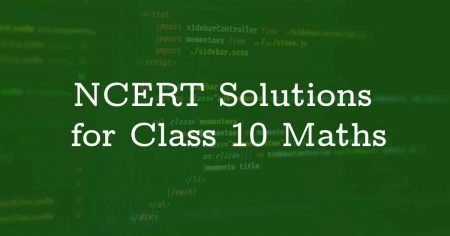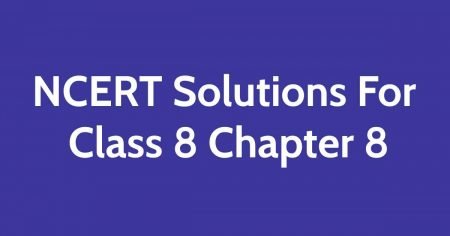NCERT Solutions for Class 9 Maths: Class 9 math NCERT solution is comprised of analysis & explanation of every chapter covered by the 9th-grade textbook. Here solutions are given in a comprehensive manner which ensures that students understand concepts properly. NCERT Solutions for Class 9 maths are set properly by some of the more accomplished experts in the Mathematics field.
NCERT Solutions for Class 9 Maths Chapter Wise
Chapter 1: Number System
This chapter explains topics of rational, irrational numbers & represents the same on a number line. Furthermore, in this chapter, students are also taught the way they can represent square roots, non-terminating and terminating decimals at a number lines.
Chapter 2: Polynomials
Here the students are introduced to the Polynomials concept. These are expressions that consist of variables & coefficients. Furthermore, the student will also learn polynomials properties like addition, division, subtraction, and multiplication along with factorization.
Chapter 3: Coordinate Geometry
Chapter 3 includes concepts of the coordinates of point xy, cartesian plane, terms, notations related to the coordinate plane which includes the y-axis, x-axis, y-coordinate, x- coordinate, origin, quadrants & more. Along with that, the students will also study the concepts of ordinates and Abscissa of a point and plotting & naming a point at xy – plane.
Chapter 4: Linear Equations in 2 Variables
This chapter introduces students to a linear equation in 2 variables which is ax+by+c=0. It’s here where the students will study how to plot the linear equation graph in 2 variables. In this chapter, the student will get questions that are related to getting solutions of linear-equation, and plotting a linear-equation on a graph.
Chapter 5: Introduction to Euclids-Geometry
Chapter 5 explains Euclid’s approach to geometry & tries to connect it with present-day geometry. This chapter gives the students a way of defining common geometrical shapes & terms. Here, the students will be explained in-depth the topic of postulates, axioms, & theorems with 2 exercises available in this chapter.
Chapter 6: Lines & Angles
In this chapter, the students will be mainly asked about proving the statements depending on axioms & theorems which are explained. 4 axioms & 8 theorems are covered in this chapter. This chapter has 3 exercises for further practicing.
Chapter 7: Triangles
Here, the students will learn about the congruence of triangles, triangle properties, rules of congruence, & the triangles inequalities. Furthermore, this chapter has about 5 exercises where the students will be asked “to-prove” and other application-level questions. Additionally, the students will learn how to prove properties that they learn in earlier classes. Additionally, the students will also learn how to apply the different congruence rules as they solve the problems.
Chapter 8: Quadrilaterals
Chapter 8 takes will take the students in-depth about Quadrilaterals topics. Furthermore, this chapter has two exercises that consist of just one theorem for proving it. However, there are about nine theorems that can be utilized in solving the conceptual or application-level questions asked. Other explained concepts include angle sum-property of a Quadrilateral, kinds of quadrilaterals, parallelogram properties, & mid-point theorem.
Chapter 9: Areas of Triangles and Parallelograms
In the previous chapter, you’ve studied the concept of quadrilaterals & triangles. Presently, you’ll study particular quadrilaterals which include parallelograms & triangles concerning the calculation of its area. Here, the students are taught about formulas for calculating area & the relationship between various geometric figures.
Chapter 10: Circles
Chapter 10 will all be about circles. The circle is defined as a collection of every point in-plane, at a fixed-distance from some fixed point at the plane. This chapter covers topics like Angle Subtended by a Chord on a Point, Equal-Chords and corresponding distances from Centre, Cyclic Quadrilaterals, Angle Subtended by Arc of Circle, & other terms which are related to circles are covered. This chapter has about twelve theorems. The student will have 6 exercises to practice on.
Chapter 11: Constructions
Chapter 11 will explain to students how they can construct triangles as they use angle bisectors. Additionally, students will learn other methods which are used for making other kinds of triangles. The Student will get 2 exercises that will help them gauge their understanding.
Chapter 12: Heron’s Formula
Heron’s Formula is used in calculating the area of a triangle when given the lengths of its sides. Students will know how to calculate the area of quadrilaterals & other polygons by dividing them into triangles & using Heron’s formula. Heron’s Formula is also used to find areas of quadrilaterals & other polygons by dividing them into triangles. There are two exercises in this chapter that assists the student in knowing the way of solving problems depending on Heron’s formula.
Chapter 13: Surface Areas & Volumes
Here the students will study how to find surface areas & volumes of cylinders and cuboids in detail & broaden the study of other solids like cones & spheres. Here, the student will get 8 exercises containing problems that are based on volumes and surface areas of various solids including cubes, cuboids, cylinders, spheres, cones, & hemispheres.
Chapter 14: Statistics
In this chapter, the students are introduced to the statistics concept & its significance plus application in various fields. Data, data representation & distribution, different kinds of graphs concepts are also described. Students will majorly learn how to calculate mean, mode, and median in this chapter. With 5 exercises the student will learn how to present data in a tabular form through keeping it together at regular intervals, histogram, bar-graph, and polygon drawing
Chapter 15: Probability
Chapter 15 offers an insight into the world of probability & its enormous applications in higher mathematics. The students will learn about the definition of probability which is chances for events to happen for a certain outcome. Questions that are in this chapter are intuitive as they’re based on our everyday life or daily situations. For instance, incidents like dice throwing, tossing a coin, deck of cards probability & other simple events.



